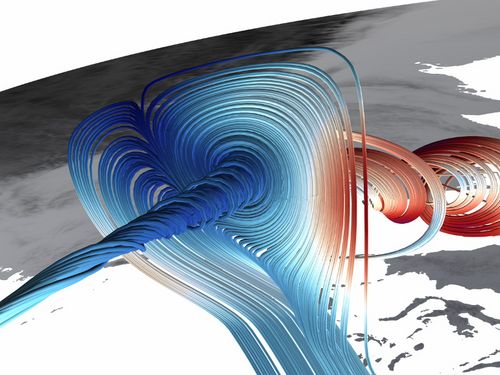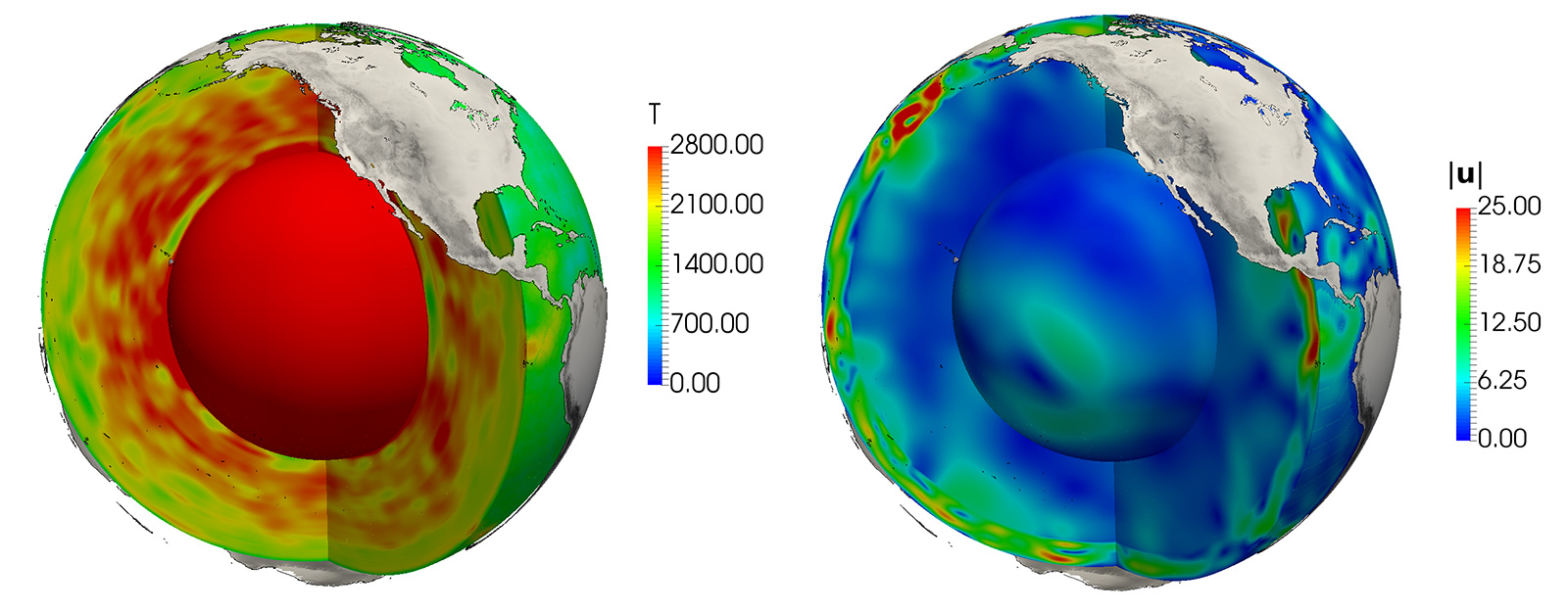ENVIRONMENT AND ENERGY
Terra-Neo: Towards Earth Mantle Convection Simulation with Hierarchical Hybrid Multigrid Solvers
Principal Investigator:
Ulrich Rüde
Affiliation:
Lehrstuhl für Informatik 10 (Systemsimulation), Friedrich-Alexander-Universität Erlangen-Nürnberg (Germany)
Local Project ID:
cher16 (JSC), TN17 (HLRS)
HPC Platform used:
JUWELS and JUQUEEN of JSC, Hazel Hen of HLRS
Date published:
Mantle convection is a vital component of the Earth system. The relentless deformation taking place in the mantle by viscous creep has a far greater impact on our planet than might be immediately evident. Immense forces are at work in mantle convection cells: continuously reshaping Earth’s surface, the mantle provides the enormous driving forces necessary to support large scale horizontal motion, in the form of plate tectonics and associated earthquake and mountain building activity. At the same time the mantle induces substantial vertical motion in the form of dynamically maintained topography through lateral pressure gradients beneath tectonic plates. This vertical motion is perhaps the most spectacular manifestation of mantle convection - and its most defining and enduring impact upon the entire Earth system.
Mantle convection modeling relies upon sophisticated computational modeling and is a classical grand challenge application requiring extremely large grids and many time steps to represent the system with spatial and temporal resolutions fine enough to allow for the use of earth-like physical parameters.
mp4 video: Velocity streamlines of a steady-state mantle convection simulation using real-world geophysical data. © Terra-Neo Consortium
In order to get prepared for the vast computing power that will become available with exascale computing technologies, researchers of the Friedrich-Alexander-Universität Erlangen-Nürnberg (FAU), the Technische Universtität München (TUM) and Ludwig-Maximilians-Universität München (LMU) have teamed up to work on an ambitious project called Terra-Neo. Goal of the collaboration, led by Prof. Dr. Ulrich Rüde of FAU, is to develop new codes for studying the dynamics below the Earth’s surface which will allow to construct a next generation mantle circulation model enabling simulation based breakthrough results in our understanding of the solid Earth.
mp4 video: Hierarchical refinement of the simulation domain using block-structured tetrahedral grids. © Terra-Neo Consortium
Leveraging the GCS supercomputing technologies available at the High-Performance Computing Center Stuttgart and the Jülich Supercomputing Centre (JSC), the scientists concentrate on algorithmic and numeric topics, such as coarse level strategies and adjoint simulations motivated by geophysical and flow problems. One of their goals is to design the hierarchical hybrid grids framework (HHG) and its successor hybrid tetrahedral grids (HyTeG) with the aim to close the gap between finite element’s flexibility and geometric multigrid’s performance by utilizing the advantages of structured and unstructured grids.
The Terra-Neo software framework is based on a carefully designed multiscale space-time approximation, built on modern finite element technology and communication-avoiding ultra-scalable multigrid for multi-physics Earth mantle models. It is developed specifically for the upcoming heterogeneous exa-scale computers by using an advanced architecture-aware co-design approach that is driven by a systematic performance engineering methodology.
For detailed information on the integrated co-design of the Terra-Neo modeling framework, please see this “teachlet video”:
mp4 Video © Terra-Neo Consortium
More information on the Terra-Neo project can be found at:
https://www.fz-juelich.de/ias/jsc/EN/Expertise/High-Q-Club/Terra-Neo/_node.html
Project Team:
Hans-Peter Bunge (Ludwig-Maximilians-Universität München/LMU), Ulrich Rüde (Friedrich-Alexander Universität Erlangen-Nürnberg/FAU, Principal Investigator), Barbara Wohlmuth (Technische Universität München)
References and Publications:
[1]S. Bauer, M. Huber, S. Ghelichkhan, M. Mohr, U. Rüde, B. Wohlmuth Large-scale Simulation of Mantle Convection Based on a New Matrix-Free Approach, Journal of Computational Science, 2019, vol. 31, pp. 60-76 (doi: 10.1016/j.jocs.2018.12.006)
[2] B. Gmeiner, M. Huber, L. John, U. Rüde, and B. Wohlmuth. A quantitative performance study for Stokes solvers at the extreme scale, J. Comput. Sci., 17(3), pp. 509-521, 2016 (doi: 10.1016/j.jocs.2016.06.006).
[3] S. Bauer, D. Drzisga, M. Mohr, U. Ruede, C. Waluga, B. Wohlmuth, A stencil scaling approach for accelerating matrix-free finite element implementations, SIAM Journal on Scientific Computing 40, no. 6 (2018): C748-C778; (doi: 10.1137/17M1148384)
[4] N. Kohl, D. Thönnes, D. Drzisga, D. Bartuschat, U. Rüde, The HyTeG Finite-Element Software Framework for Scalable Multigrid Solvers, International Journal of Parallel, Emergent and Distributed Systems (2019), 34(5), 477-496 , (doi: 10.1080/17445760.2018.1506453)
For a comprehensive list of references, please refer to the Terra Neo website.
Scientific Contact:
Prof. Dr. Ulrich Rüde
Friedrich-Alexander Universität Erlangen-Nürnberg
Department of Computer Science
Chair of Computer Science 10 (System Simulation)
Cauerstr. 11, D-91058 Erlangen (Germany)
e-mail: ulrich.ruede [@] fau.de
https://cs10.tf.fau.de/ulrich-ruede
Project ID(s): cher16 (JSC), TN17 (HLRS)
Date published: January 2020

